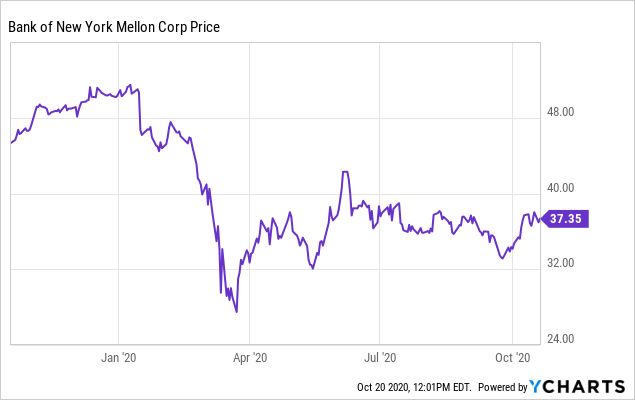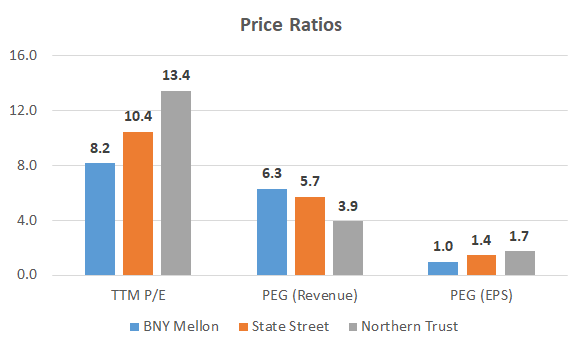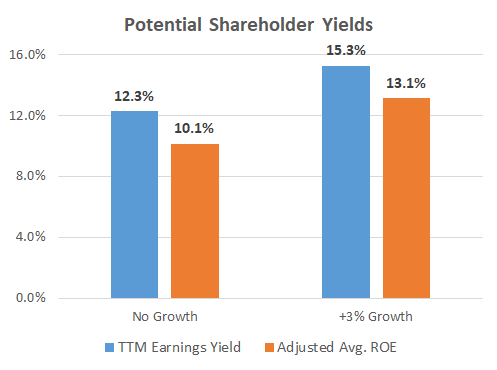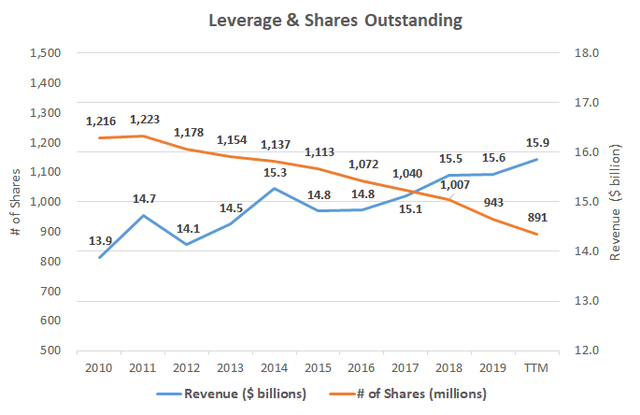The resiliency of Bank of New York Mellon (BK) in a low interest rate environment leaves the business looking like a great value investment sitting at an 8.2x trailing-twelve month P/E ratio and 0.85x book value. The majority of BNY Mellon’s revenue (81%) is earned from fee income with net interest income making up a much less significant portion (18%). This resiliency was evident when BNY Mellon reported Q3 2020 operating results on October 16th which showed total revenue decreased less than 1% with EPS down 8%. This small decrease in revenue and EPS looks out of line with the steep decline in share price and opens up a good entry opportunity for value investors.
 Data by YCharts
Data by YChartsA Profitable & Growing Company
BNY Mellon’s strong service offerings have allowed the company to achieve an average return on equity (ROE) of 8.6% over the past decade. While this level of profitability is below my rule of thumb of 15% ROE, in my opinion, the company is able to maintain and continue to increase its intrinsic value over a business cycle as witnessed by its rising book value per share. As I will discuss later in this article, even a business with a mediocre ROE can still make a great investment at the right price.
 Source data from Morningstar
Source data from Morningstar
Slow Revenue Growth… but Large Share Buybacks
BNY Mellon’s revenues have been only slowly growing over the past decade at an average compound rate of 1.3%. However, the company has also been buying back large amounts of shares helping to drive EPS growth well above the level of revenue growth. As can be seen in the graph below, since 2010, the company has managed to decrease its outstanding shares by 26.7% from 1,216 million to 891 million today, for an annual average compound repurchase rate of 3.1% per year. Combined with the company’s current 3.4% dividend yield, this average repurchase rate would bring total shareholder yields up to 6.5%.
Source data from Morningstar
These large share buybacks look ripe to continue with BNY Mellon’s CET1 ratio a healthy 13.0% and dividends well covered with a payout ratio of only 29.9% in 2019, leaving room for excess cash to be used to repurchase shares. The company’s commitment to continue repurchasing shares as part of the capital budget is evident with CEO, Todd Gibbons, stating in the Q3 2020 earnings release that “our business model continues to generate significant excess capital. We look forward to recommencing share buybacks as soon as possible, which we expect to be meaningfully accretive to EPS”.
Price Ratios and Potential Returns
When looking at steady growth companies such as BNY Mellon, a good tool to use is legendary investor Peter Lynch’s PEG ratio. To get an idea of how BNY Mellon’s market valuation compares to financial service peers State Street (STT) and Northern Trust (NTRS), I have placed them all side by side.


Source data from Morningstar
As can be seen, BNY Mellon’s TTM P/E ratio is the least expensive of the peer group at 8.2x. Additionally, the company also has the highest average annual EPS growth rate over the past 10 years at 8.4% which brings its PEG (EPS) to again be the lowest at 1.0x. This important PEG (EPS) falls well below Peter Lynch’s rule of thumb of being under 2x (a PEG ratio over 2 suggests that earnings growth is already built into the price).
I always like to examine the relationship between average ROE and price-to-book value in what I call the Investors’ Adjusted ROE. This relationship is especially important for cyclical companies, and is something I consider similar to Shiller’s CAPE ratio but a little simpler to calculate, in my opinion. It examines the average ROE over a business cycle, and adjusts that ROE for the price investors are currently paying for the company’s book value or equity per share. With BNY Mellon earning an average ROE of 8.6% over the past decade and shares currently trading at a price-to-book value of 0.85x when the price is $37.40, this would yield an Investors’ Adjusted ROE of 10.1% for an investor’s equity at that purchase price, if history repeats itself. This is already above the 9% that I like to see, and adding a 3% growth rate to represent the company’s continued growth through share repurchases could increase this potential total return up to 13.1%.

Takeaway
BNY Mellon’s fee driven business model is resilient in a low interest rate environment as witnessed by Q3 2020 results. The company does a great job returning capital to shareholders through both dividends and share repurchases which combine to approximate total shareholder yields of 6.5%. The disconnect between the company’s share price and performance opens up a good entry point for long-term value investors at only 8.2x TTM P/E and a PEG (EPS) ratio of only 1.0x.
Disclosure: I am/we are long BK, STT. I wrote this article myself, and it expresses my own opinions. I am not receiving compensation for it (other than from Seeking Alpha). I have no business relationship with any company whose stock is mentioned in this article.
Additional disclosure: I am long BK and STT with an average cost base of $35.99 and $61.16, respectively.
Disclaimer: While the information and data presented in my articles are obtained from company documents and/or sources believed to be reliable, they have not been independently verified. The material is intended only as general information for your convenience, and should not in any way be construed as investment advice. I advise readers to conduct their own independent research to build their own independent opinions and/or consult a qualified investment advisor before making any investment decisions. I explicitly disclaim any liability that may arise from investment decisions you make based on my articles.

